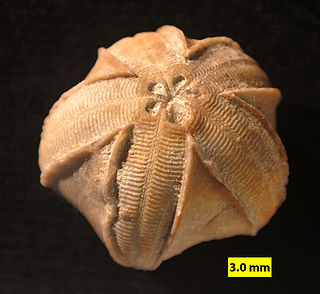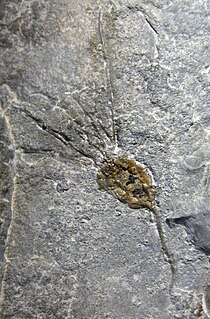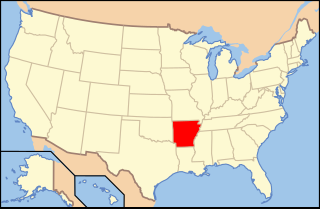
Crinoids are marine animals that make up the class Crinoidea, one of the classes of the phylum Echinodermata, which also includes the starfish, brittle stars, sea urchins and sea cucumbers. Those crinoids which, in their adult form, are attached to the sea bottom by a stalk are commonly called sea lilies, while the unstalked forms are called feather stars or comatulids, being members of the largest crinoid order, Comatulida.

Blastoids are an extinct type of stemmed echinoderm, often referred to as sea buds. They first appear, along with many other echinoderm classes, in the Ordovician period, and reached their greatest diversity in the Mississippian subperiod of the Carboniferous period. However, blastoids may have originated in the Cambrian. Blastoids persisted until their extinction at the end of Permian, about 250 million years ago. Although never as diverse as their contemporary relatives, the crinoids, blastoids are common fossils, especially in many Mississippian-age rocks.

Monte Sano Mountain is a mountain located in Huntsville, Alabama. The name Monte Sano is Spanish for "Mountain of health". This name comes from the fact that curative health resorts used to be located on the mountain to take advantage of the fresh air, clean water, and cooler temperatures.

Gerardus Troost was a Dutch-American medical doctor, naturalist, mineralogist, and founding member and first president of the Philadelphia Academy of Natural Sciences.

Gogia is a genus of primitive eocrinoid blastozoan from the early to middle Cambrian.

In biology, a test is the hard shell of some spherical marine animals, notably sea urchins and microorganisms such as testate foraminiferans, radiolarians, and testate amoebae. The term is also applied to the covering of scale insects. The related Latin term testa is used for the hard seed coat of plant seeds.

Crinozoa is a subphylum of mostly sessile echinoderms, of which the crinoids, or sea lilies, are the only extant members. Crinozoans have an extremely extensive fossil history, which may or may not extend into the Precambrian.

Pentremites is an extinct genus of blastoid echinoderm belonging to the family Pentremitidae.
Deltoblastus is a genus of blastoid echinoderms that lived in the Permian. Its fossils are known from Asia.
Cryptoblastus is a genus of extinct blastoids, a primitive group of echinoderms related to the modern sea lilies. Fossils are found in sedimentary rocks laid down in the Early Carboniferous period some 360 to 320 million years ago.

The Devonian Jeffersonville Limestone is a mapped bedrock unit in Indiana and Kentucky. It is highly fossiliferous.

Paleontology in Georgia refers to paleontological research occurring within or conducted by people from the U.S. state of Georgia. During the early part of the Paleozoic, Georgia was largely covered by seawater. Although no major Paleozoic discoveries have been uncovered in Georgia, the local fossil record documents a great diversity of ancient life in the state. Inhabitants of Georgia's early Paleozoic sea included corals, stromatolites, and trilobites. During the Carboniferous local sea levels dropped and a vast complex of richly vegetated delta formed in the state. These swampy deltas were home to early tetrapods which left behind footprints that would later fossilize. Little is known of Triassic Georgia and the Jurassic is absent altogether from the state's rock record. During the Cretaceous, however, southern Georgia was covered by a sea that was home to invertebrates and fishes. On land, the tree Araucaria grew, and dinosaurs inhabited the state. Southern Georgia remained submerged by shallow seawater into the ensuing Paleogene and Neogene periods of the Cenozoic era. These seas were home to small coral reefs and a variety of other marine invertebrates. By the Pleistocene the state was mostly dry land covered in forests and grasslands home to mammoths and giant ground sloths. Local coal mining activity has a history of serendipitous Carboniferous-aged fossil discoveries. Another major event in Georgian paleontology was a 1963 discovery of Pleistocene fossils in Bartow County. Shark teeth are the Georgia state fossil.

Paleontology in Arkansas refers to paleontological research occurring within or conducted by people from the U.S. state of Arkansas. The fossil record of Arkansas spans from the Ordovician to the Eocene. Nearly all of the state's fossils have come from ancient invertebrate life. During the early Paleozoic, much of Arkansas was covered by seawater. This sea would come to be home to creatures including Archimedes, brachiopods, and conodonts. This sea would begin its withdrawal during the Carboniferous, and by the Permian the entire state was dry land. Terrestrial conditions continued into the Triassic, but during the Jurassic, another sea encroached into the state's southern half. During the Cretaceous the state was still covered by seawater and home to marine invertebrates such as Belemnitella. On land the state was home to long necked sauropod dinosaurs, who left behind footprints and ostrich dinosaurs such as Arkansaurus.

Paleontology in Iowa refers to paleontological research occurring within or conducted by people from the U.S. state of Iowa. The paleozoic fossil record of Iowa spans from the Cambrian to Mississippian. During the early Paleozoic Iowa was covered by a shallow sea that would later be home to creatures like brachiopods, bryozoans, cephalopods, corals, fishes, and trilobites. Later in the Paleozoic, this sea left the state, but a new one covered Iowa during the early Mesozoic. As this sea began to withdraw a new subtropical coastal plain environment which was home to duck-billed dinosaurs spread across the state. Later this plain was submerged by the rise of the Western Interior Seaway, where plesiosaurs lived. The early Cenozoic is missing from the local rock record, but during the Ice Age evidence indicates that glaciers entered the state, which was home to mammoths and mastodons.

Paleontology in Oklahoma refers to paleontological research occurring within or conducted by people from the U.S. state of Oklahoma. Oklahoma has a rich fossil record spanning all three eras of the Phanerozoic Eon. Oklahoma is the best source of Pennsylvanian fossils in the United States due to having an exceptionally complete geologic record of the epoch. From the Cambrian to the Devonian, all of Oklahoma was covered by a sea that would come to be home to creatures like brachiopods, bryozoans, graptolites and trilobites. During the Carboniferous, an expanse of coastal deltaic swamps formed in areas of the state where early tetrapods would leave behind footprints that would later fossilize. The sea withdrew altogether during the Permian period. Oklahoma was home a variety of insects as well as early amphibians and reptiles. Oklahoma stayed dry for most of the Mesozoic. During the Late Triassic, carnivorous dinosaurs left behind footprints that would later fossilize. During the Cretaceous, however, the state was mostly covered by the Western Interior Seaway, which was home to huge ammonites and other marine invertebrates. During the Cenozoic, Oklahoma became home to creatures like bison, camels, creodonts, and horses. During the Ice Age, the state was home to mammoths and mastodons. Local Native Americans are known to have used fossils for medicinal purposes. The Jurassic dinosaur Saurophaganax maximus is the Oklahoma state fossil.

The Cuyahoga Formation is a geologic formation in Ohio. The age of the formation is difficult to determine, because of a lack of diagnostic fossils. Roughly, the formation dates from the Late Kinderhookian to the Middle Osagean. Eight members are recognized, among them the Orangeville Shale, Sharpsville Sandstone, and Meadville Shale.

The Milwaukee Formation is a fossil-bearing geological formation of Middle Devonian age in Milwaukee County, Wisconsin. It stands out for the exceptional diversity of its fossil biota. Included are many kinds of marine protists, invertebrates, and fishes, as well as early trees and giant fungi.
The Hindsville Formation, or Hindsville Limestone Member of the Batesville Formation, is a geologic unit in northern Arkansas and eastern Oklahoma that dates to the Chesterian Series of the late Mississippian. Named for the town of Hindsville in Madison County, Arkansas, this unit is recognized as a member of the Batesville Formation in Arkansas and a geologic formation in Oklahoma. Although, some workers have proposed raising the rank of this interval in Arkansas to formation status. Both the Batesville and Hindsville Formations overlie the Moorefield Formation and underlie the Fayetteville Shale.
The St. Joe Formation or St. Joe Limestone Member is a geologic formation or member in northern Arkansas, southern Missouri and northeastern Oklahoma. It preserves fossils of the Mississippian subperiod including crinoids, brachiopods, bryozoa, conodonts, blastoids, ostracods and rugose coral.
A blastoid is an embryoid, a stem cell-based embryo model which, morphologically and transcriptionally, resembles blastocysts, resulting in it undergoing implantation on being introduced into the womb of a compatible female. The first blastoids were created by the Nicolas Rivron laboratory by combining mouse embryonic stem cells and mouse trophoblast stem cells. Upon in vitro development blastoids generate analogs of the primitive endoderm cells, thus comprising analogs of the three founding cell types of the conceptus. As compared to other stem cell-based embryo models, blastoids model the pre-implantation stage and the integrated development of the whole conceptus including the embryo proper and the two extraembryonic tissues. The blastoid is a model system for the study of mammalian development and disease.












